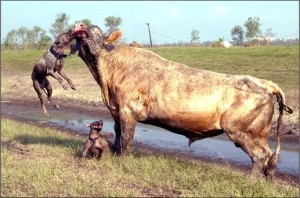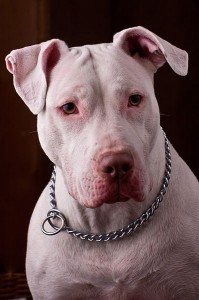We use the term ‘pit bull type dog’ because that is biologically the most accurate term. In order to understand this, you have to look at the biological history of the present day pit bull type dogs. Their history is twofold.
 The bulldog: The bull-baiting, bear-baiting, horse-shredding ‘bulldog’ has existed at least since the reign of Richard III in England (1452 – 1485), when watching ‘bulldogs’ slowly torture bulls, bears, horses and other animals to death was considered normal public entertainment. These dogs were also used to hunt wild boar, not only tracking the boar but engaging directly in killing it, and in dogfighting matches where they were pitted against each other in fights to the death. There were no breed clubs to give these dogs fancy names — they were called simply ‘bulldogs’. The term ‘pit bull’ was an American variation on the same theme, referring to any of the pit fighting bulldog types.
The bulldog: The bull-baiting, bear-baiting, horse-shredding ‘bulldog’ has existed at least since the reign of Richard III in England (1452 – 1485), when watching ‘bulldogs’ slowly torture bulls, bears, horses and other animals to death was considered normal public entertainment. These dogs were also used to hunt wild boar, not only tracking the boar but engaging directly in killing it, and in dogfighting matches where they were pitted against each other in fights to the death. There were no breed clubs to give these dogs fancy names — they were called simply ‘bulldogs’. The term ‘pit bull’ was an American variation on the same theme, referring to any of the pit fighting bulldog types.
Until the late 19th century, the only pedigree that mattered for any bulldog was its fighting pedigree – the list of kills it had committed on some other bulldog in the fighting pit. It wasn’t until early in the 20th century, as dogfighting declined, that the breeders of these dogs sought other ways to sell them. They turned to the new kennel clubs, which had been established to cater to the upper class hobby of breeding dogs for shows. After much lobbying, the 1930s saw the registration and re-branding of the pit fighting bulldogs by various kennel clubs, always with a name intended to hide the type’s bloody history (eg, changing this molosser’s name from bulldog to ‘Staffordshire terrier’). Since that first deception, many new breed clubs have arisen, dedicated to producing slight physical variation in the fighting bulldog so as to claim a new pit bull type ‘breed’ all their own (eg, American Bully, Pit Bull XXL, Olde English Bulldogge, American Bulldog).
All of these dogs in fact come from the same limited gene pool, all of them retaining both the physical and the behavioral traits that have always typified the fighting bulldog. Pasting a new ‘breed’ label on yet another slight variation of the pit fighting bulldog does not change this fact.
The war dog: The Romans had left a legacy behind in Southern and Eastern Europe of their Roman slave-shredding war dogs. What we now call ‘mastiffs’ are probably distantly related to these war dogs the Romans had kept, many of them meanwhile developed into regional variations of the original biological population.
In the period when Richard III was watching his bulldogs shred large animals to death, Europeans were starting to discover and colonize the globe. They transported their ‘mastiff’ dogs, many of which were already mixed with fighting bulldogs, to newly discovered territories to conquer, cow, terrorize and sometimes even eradicate native human populations for the sake of colonization. Tired remnants of these war dogs remained in these countries long after the colonial period ended, mostly chained in yards or on farms as guard dogs. In places where dogfighting was popular, many of them were again mixed with fighting bulldogs, creating local variations that were named for wherever the mix had been made (eg, the Cordoba fighting dog).
The arms race
Most lately we’ve seen a modern arms race in circles that favor this type of inherently dangerous dog, leading to the mixing of ever more local mastiff types with fighting bulldog / pit bull types. The fans of the new mix then apply to kennel clubs to have their own pit bull – mastiff mix recognized as a new ‘breed’. It’s this arms race, with its greed for cash, that has given us the many pit bull mixes people are now pretending are a separate mastiff ‘breed’: the ‘Cane Corso’, ‘Dogo Argentino’, ‘Dogue de Bordeaux’, ‘Bullmastiff’, to name a few.
The instant a kennel club dispenses a new official name for such a mix, the mix’s fans start to claim that their ‘breed’ is distinct. Suddenly the newest pit fighting bulldog – mastiff mix is a ‘breed’ that has nothing to do with any other pit bull, mastiff, or pit bull – mastiff mix, as if the new mix’s genes materialized out of thin air.
In fact, these pit bull – mastiff mixes are pit bull type dogs, no less than any other backyard-bred pit bull mix.
 Why not just call them pit bulls?
Why not just call them pit bulls?
We, dogfighters, and the law used to. Even the fur-mommy pit bull fans did. When the first laws were introduced to restrict or ban the ‘pit bull’, its fur-mommy fans were alarmed. They suddenly appeared everywhere to explain to us: “You can’t ban pit bulls, because it’s not a breed but a type of dog.” As deaths by this type of dog continued to mount, wise lawmakers listened to the fur-mommies’ wisdom – laws began to specify that restrictions applied to various ‘breeds’ that were of the pit bull type. The laws included all dogs (regardless of breed labels or mixed background) that displayed the main characteristics of this type of dog, and they include any mixes thereof. The American courts have also repeatedly taken this same position.
Most of the public understands nowadays that the distinction between the various fighting bulldog ‘breeds’ are a fiction, and that they are all included when we say ‘pit bull’. There is still some confusion about the pit bull – mastiff mixes. This is likely partly because they are so much larger than what people generally think of as a pit bull, and partly because of the invented ‘breed’ names that suggest these mixes are some local invention, unmixed with anything outside their area of origin. This is a fiction – the common thread that runs through all of these ‘mastiff’ types is the mixing of already inherently aggressive local mastiffs with fighting bulldog types.
All of these dogs come from juggling with the same narrow gene pool. In the end, they are all descended from dog types that were used either to maul bears, cattle and humans to death for entertainment, as well as to eradicate native populations in various colonies, and/or from pit fighting bulldogs that were mostly only pitted against each other and wild boar. They are a result of centuries of human selection for abnormally disinhibited behavior, a specific tenacious and deadly bite, grip and shear attack pattern, and the physical characteristics to make defense against an attack almost impossible.
They are all of them genetically and behaviorally closely related, all of them pit bull type dogs.

I think I missed the point of this post.
Reading this again I need something clarified. Are you saying pits are becoming more commonly mixed with various mastiffs? Because pits and mastiffs, while sharing lineage, are separate breeds. From my understanding, the four “true” pit bulls were bred starting in 1835 for the sole purpose of bloodsport. Mastiffs have a bloody history, but they had purposes outside of fighting. Over time pits started being bred into many mastiff bloodlines, but it sounds misleading to declare every mastiff, pit-type dogs (as opposed to grippers or Molossors) from the start. Especially since a lot of existing mastiffs were bred before 1835.
According to Merrit Clifton, English Mastiff is just another word for American Pit Bull Terrier, cause all of them dogs are one and the same, but that still don’t answer my question about Rottweilers, unless Rottweiler also is just another word for American Pit Bull Terrier.
“All of these dogs come from juggling with the same narrow gene pool”…….according to your DNA there is only a narrow difference between you and a banana. LOL
While entertaining, alarmist hand wringing is unless and totally ignores the real problem.
If you really believe there is no difference between a so called pit bull and other dogs that predate them like English mastiffs or what are now called American bulldogs, you’re just outing yourself as ignorant.
There are several working breeds under the “bulldog” umbrella, and repeatable breeders who contentiously maintain their respective breeds by cultivating animals with useful and more harmless characteristics.
You come off as knee jerk and foolish, trying to conflate legitimate dog breeds with animals produced in back yards and trailer parks.
Inform yourself and have the intellectual honesty to differentiate between an dog that looks scary to you, and what the self created underclass of hood rats and hillbillies want in an animal. If you were calling for a ban on unskilled and irresponsible breeding by low class people who think is cool to have a killer dog, I could agree with you. But you aren’t calling for anything of use, just stoking the issue. If as you clam all Molossers are “inherently dangerous” they would be dozens of attacks daily, given the number of these dogs across the country. But there aren’t, and the incidents that do happen have many more factors that breed in play.
Don’t get me wrong, I don’t defend and condone “pit bulls” or other animals that are breed to be destructive or otherwise harmful. I don’t personally own a dog, due to my location. So you can literally apply the old adage that I don’t have a dog in this fight. But I have owned several America Bull dogs, real ones, not a puppy I got from a friend of a friend who assures me it the real thing. These dogs can be traced for many generations and have been breed by responsible professionals who weed out violent and anti-social dogs. The breeder I got my dogs from is still operating today, providing cattle handling ans service dogs. And this breeder isn’t the only example, you just don’t often hear about them because it’s not their dogs who attack people. There are without a doubt dogs that have been bred by idiots, and are unstable and very deadly. No amount of training will ever fix a dog that is badly inbreed or defective do to over breeding for the wrong characteristics. Dogs like the ones Micheal Vic was sent to jail over, or the ones attacking the cow above, don’t act out of animal instinct or hunger. They are just broken because someone created them that way. That, how ever, is NOT the case with all breeds. The ironic part of this are the breeds you listed that were created to take advantage of a breeds better qualities. They are the result of efforts to create a breed that could be useful while not poising a danger to anyone, but end up being condemned for simply looking like another dog. Careless breeding is the root of the problem, the best example of this are the little “pocket” dogs that have become so popular. These dogs constantly exhibit aggression towards nearly everyone. Folks who are afraid of large breeds are bothered by them, but constant barking and and anti-social posturing is typical behavior for toy class dogs, or any pet you might find of a purse. Otherwise good breeds like German shepherds and Jack Russel have been nearly destroyed by reckless breeding.
This is an uncomplicated issue being made complicated by people with an agenda.
‘The man biters were culled’ is a common myth, but only a myth. The godfather of American pit bulls, John Colby, managed to get his 2 year old nephew killed in a ‘yard accident’ by one of his man biters. The Dogmen didn’t care who got bit as long as the dog made money, and there are many accounts of dogmen being bit and their wives having bite scars: https://cravendesires.blogspot.com/2010/05/john-p-colby-fountainhead-of-american.html
The type of aggression that was SELECTED FOR in FIGHTING BREED dogs-explosive, disproportionate, and unprovoked-is more complex and cannot be trained out, socialized out, or loved out with bellyrubs. We know from the example of the English Bulldog that it took 300 years of CAREFUL and CONTROLLED breeding to turn them from fighters into relatively safe pets. Pit breeding is anything BUT careful or controlled, and mostly of the backyard variety or done by people trying to make MORE aggressive dogs. In the absence of a proper target pit bulls have been known to attack people (frequently their owners and family-voicesofthevictims.org) as well as trains, planes, cars (https://blog.dogsbite.org/2011/02/its-official-pit-bulls-attack-planes.html) and concrete pigs (http://americasdog.blogspot.com/2013/03/idiot-dog-vs-cement-pig.html). This is not the behavior of a breed that is wired right to be a pet animal.
Sounds funny, that it took 300 years of careful and controlled breeding to turn the English Bulldog into a relative safe pet, when the English Bulldog was created as a show dog, long after the original Bulldog had left the scene i England, and the so called English Bullterrier was also created as a show breed, so none of them was actually ever a so called working dog, just so you know.
Can anyone explain to me, why Rottweiler comes in second when it comes to killing people in the U.S, when Rottweiler is not a fighting breed, and Rottweiler is not a mix of different types of so called Pit Bull’s, cause I would like to know why?
Probably because the Rott was not BRED to be a fighting BREED dog. Rottweiler deaths are quite distant from pit bulls; by a factor of more than three to one.
http://www.usatoday.com/story/news/nation/2015/03/02/new-dog-laws-wont-target-pit-bulls/24293619/
When everything from the smallest Staffordshire Bull Terrier’s to the biggest so called Old English Mastiff’s are called Pit Bull’s, it’s no wonder they come in as number one, when it comes to killing people, cause you are actually talking about many different breeds, and mixes of those breeds, but Rottweiler is only one breed of dog.
To be precise, the “true” pit bulls are American pit bull terriers, American Staffordshire terriers, Staffordshire bull terriers, and American bulldogs. These dogs were specifically bred for bloodsport, though I think Ambulls were shifted to multi-purpose dogs so the dogmen could cover themselves. Grouping does need to be updated and exact, however, as pits get more commonly mixed into other breeds, and as grippers become more commonplace overall.
This post nails why I dislike every mastiff and nearly every bully breed–they go beyond protection and controlled levels of aggression. These are dogs steeped in centuries of bloody history, deliberately utilized for terrorism and senseless violence. And the owners try to cover it up. Is it supposed to magically go away now that we’ve turned these dogs into pets and tried to channel their instincts into different tasks?
Fila Brasilieros are a counterpart to the extinct(?) Cuban bloodhound, one of the plantation breeds. Filas are so distrustful of strangers that they DON’T get docked points for showing aggression to dog show judges. Sometimes people cite that bloodhounds were once considered aggressive (Uncle Tom’s Cabin mentioned them, I believe), but that’s referring to Cuban bloodhounds, which were more mastiff than hound. The English bloodhound we all know hasn’t been a controversial breed.
I also think it’s a linguistic thing. There’s something prettier about saying “pit-bull type dog”, something more innocent. There are similar lines in saying a pit bull “bit” someone or that the pit bull (sorry, Lab mix) in the shelter “doesn’t always get along with strangers or other dogs…but he’s really friendly!”
Nice work as usual, Mr. Bordchart. I find it terribly ironic that you can talk to dog-lovers all day about different breeds, yet when the topic shifts to something controversial it’s suddenly all in how you raise them. You can discourage a dog’s breeding but you can’t erase it. That’s a more insidious myth than many give it credit for.
Cardinal: there’s an excellent rendering of the extinct Cuban Bloodhound at the following url: http://retrieverman.net/2011/08/02/one-of-the-cuban-bloodhounds-from-the-andersonville-prison/ SRUV discussed the Bloodhound issue in our post on Vicki Hearne: http://sruv-pitbulls.blogspot.com/2014/04/vicki-hearne.html